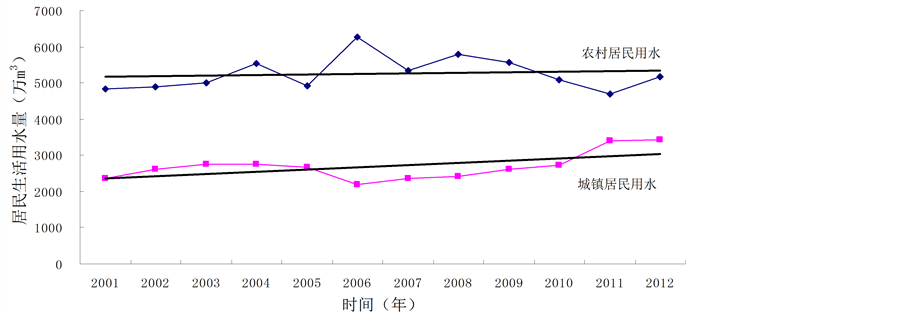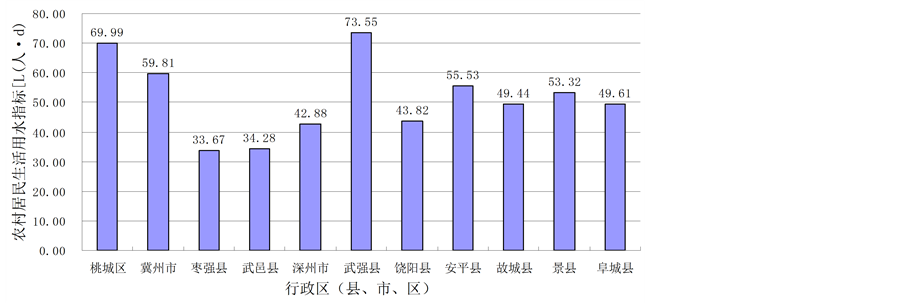1. 引言
衡水市位于河北省东南部平原,东径115˚10'~116˚34'北纬37˚03'~38˚23'之间,南北最长距离125.3 km,东西最宽距离98.1 km,全市行政区域面积8815 km2。衡水市东南隔卫运河与山东省相望,东面、北面与沧州市、保定市相邻,西面、南面与石家庄、邢台接壤[1] 。
衡水市皆为平原区,地势平坦。东部海拔高度(黄海)28.0~12.0 m之间,西部海拔30.0~12.0 m之间。地形自西南向东北缓慢倾斜,地面坡降1/4000~1/10000。地貌为冲洪积、冲湖积平原区。由于历史上黄河、漳河、滹沱河在境内多次冲决泛滥,致使区内微地貌比较复杂,古河床和低矮沙丘、岗坡相互交错,形成许多条带状封闭洼地。衡水市土壤大多为壤土、沙壤土、粘性土,适应于多种农作物的生长。
2. 生活用水结构分析
根据河北省用水资料统计方法和内容,用水分类有农业灌溉用水、林牧渔畜业用水、工业用水、城镇公共用水、居民生活用水、生态环境用水等[2] 。
农业用水包括水田、水浇地、菜田用水等。林牧渔畜用水量包括林果灌溉、草场补水、鱼塘补水、牲畜用水等。工业用水按火(核)电、国有及规模以上企业、规模以下企业统计。城镇公共用水量包括建筑业和服务业两项用水。居民生活用水量按城镇生活和农村生活用水。生态环境用水分为城镇环境和农村环境用水量等。
设在一定时间尺度内,共有n种用水户类型{X1, X2,  , Xn},每个用水户用水量可表示为{W1, W2,
, Xn},每个用水户用水量可表示为{W1, W2,  , Wn},各部门用水量比例为:
, Wn},各部门用水量比例为:

式中: .
.
式中:Pi为第i种行业占总用水量的比例,%;Wi为第i种行业用水量,万m3;W为各用水行业总用水量,万m3。
根据衡水市2001~2012年用水量资料[3] ,多年平均用水量16.2906亿m3。计算各行业用水量多年平均值,分析各行业用水结构:农业用水占总用水量的82.02%,工业用水占总用水量的6.46%,居民生活用水占总用水量的4.88%,林牧渔畜业用水量占总用水量的5.48%,生态环境用水和城镇公共用水分别为0.35%和0.81%。图1为衡水市各用水行业用水结构柱状图。
3. 生活用水变化特征
要对现象变动趋势进行动态分析,就要建立与长期趋势相适应的数学模型。最常用的一种配合直线趋势模型的方法是最小平方法,又称最小二乘法[4] 。其变化趋势直线方程为:

式中:Yt为时间序列的趋势值;a为截距项;b为趋势线斜率;t为时间标号。
用水量变化,受多种因素影响。分析用水量变化趋势,掌握其变化规律,对合理开发利用水资源有重要意义。
生活用水分为城镇生活用水和农村生活用水。根据衡水市2001~2012年生活用水量统计资料,城镇生活多年平均用水量2693万m3,占生活用水总量的33.8%;农村生活用水量5263万m3,占总量的66.2%。
生活用水量变化受人口数量和生活质量的影响。衡水市城镇生活用水量变化平稳,总体呈上升趋势。农村生活用水量变化幅度较大,年际变化维持在一个相对平稳的状态。图2为衡水市生活用水年际变化过程线。
根据衡水市城镇居民生活用水和农村生活用水变化趋势方程,分别求其年际变化情况,农村居民生活用水平均每年增长16万m3,城镇居民生活用水平均每年增长61万m3。生活用水基本上维持在一个相对稳定水平。
4. 用水指标分析
人均日生活用水量指每一用水人口平均每天的生活用水量。一般是指使用公共供水设施或自建供水设计供水的,城市居民家庭日常生活使用的自来水。其具体含义为用水人是城市居民;用水地是家庭;用水性质是维持日常生活使用的自来水[5] 。
利用2011年衡水市各县市区城镇、农村居民用水量资料,分析其用水指标变化。衡水市各县市区城

Figure 1. The proportion of water column industry in Hengshui city
图1. 衡水市行业用水比例柱状图
镇生活用水平均指标为53.49 L/(人·d),农村居民生活用水平均指标为49.02 L/(人·d)。表1为衡水市居民生活用水指标与用水量统计表。
通过对衡水市城镇居民生活用水量指标分析,城镇居民生活用水指标为
53.49L
/(人·d),各县市区用水指标差距较大,用水指标最大的是安平县,为96.91 L/(人·d)。最小的是饶阳县,为
24.65L
/(人·d)。图3为衡水市各县市区城镇生活用水指标柱状图。
通过对衡水市农村居民生活用水指标分析,平均用水指标为49.02 L/(人·d),各县市区用水指标相差较大。用水指标最大的是武强县,为75.55 L/(人·d)。用水指标最小的是枣强县,为33.67 L/(人·d)。图4为衡水市各县市农村生活用水指标柱状图。
5. 生活用水变化影响因素分析
影响生活用水定额的因素很多,如当地的水资源和气候条件、人民的生活水平、生活习惯、收费标

Figure 2. Hengshui city living water interannual variation
图2. 衡水市生活用水年际变化过程线

Table 1. Hengshui city residents living water indicators and water tables
表1. 衡水市居民生活用水指标与用水量情况统计表

Figure 3. Hengshui counties and towns urban living water index histogram
图3. 衡水市各县市区城镇生活用水指标柱状图

Figure 4. Column index of domestic water in rural areas of Hengshui city and each county
图4. 衡水市各县市农村生活用水指标柱状图
准及办法、管理水平、水质和水压等因素有关[6] 。居民用水会随着人们生活质量的提高而提高,而且,人口增长也会导致生活用水量的增长。根据衡水市2001~2012年居民生活用水资料分析,农村居民生活用水平均每年增长16万m3,城镇居民生活用水平均每年增长61万m3。居民生活用水几乎维持在一个相对稳定的水平。
生活用水量能保持在一个相对不变的水平,源于开展节水措施和利用经济杠杆等作用。
5.1. 节水措施
节水型用水器具的推广应用,是生活节水的重要技术保障[7] 。
采用节水型器具,包括节水型水嘴,节水型便器,节水型便器系统,节水型便器冲洗阀,节水型淋浴器,节水型洗衣机等。大力倡导使用节水器具,提高节水器具的普及率,是节约生活用水方面的一项重要措施。
推广节水型水龙头。推广非接触自动控制式、延时自闭、停水自闭、脚踏式、陶瓷磨片密封式等节水型水龙头。淘汰建筑内铸铁螺旋升降式水龙头、铸铁螺旋升降式截止阀。
推广节水型便器系统。推广使用两档式便器,新建住宅便器小于6.0 L。公共建筑和公共场所使用6.0 L的两档式便器,小便器推广非接触式控制开关装置。淘汰进水口低于水面的卫生洁具水箱配件、上导向直落式便器水箱配件和冲洗水量大于9.0 L的便器及水箱。
推广节水型淋浴设施。集中浴室普及使用冷热水混合淋浴装置,推广使用卡式智能、非接触自动控制、延时自闭、脚踏式等淋浴装置;宾馆、饭店、医院等用水量较大的公共建筑推广采用淋浴器的限流装置。
5.2. 调整水价
衡水市自来水基本水价自1996年以来,已经做过五次调整,居民生活用水价格由0.45元/m3调至2010的1.90元/m3,调幅高达320%,污水处理费经三次制定与调整,居民生活用水类由1998年0.17元/m3上调至0.45元/m3,调幅165%。
2011年,居民生活用水由1.90元/m3调整为2.35元/m3,民政部门和工会确定的低保户和特困职工户用水由0.55元/m3调整为0.70元/m3;行政事业、工商企业和宾馆、餐饮服务用水价格合并为其它类用水价格,由现行2.40元/m3、2.50元/m3、6.00元/m3统一调整为4.10元/m3;特种行业用水价格由20.00元/m3调整为25.00元/m3。
城市家庭用水需求价格弹性。根据家庭用水的特点,其需求价格弹性可以表述为:水价的相对变动所引起的需水量的相对变动,即其需水量的变化率与水价变化率之比:

式中:Pe为城市家庭用水需求价格弹性; 为需水量的变动量;
为需水量的变动量; 为水价的变动量;p为水价的绝对量;q为需水量的绝对量。
为水价的变动量;p为水价的绝对量;q为需水量的绝对量。
按照需求法则,需水量与水价成反向变动,Pe为负值。根据需求价格弹性为缺乏弹性的特点,其绝对值 。随着水价增加,需求价格弹性逐渐增大[8] 。
。随着水价增加,需求价格弹性逐渐增大[8] 。
按照市场供求法则,水价上升,需水量将下降,收入增加需水量将增加。利用价格杠杆,调整水价,促进节水工作。合理调整城市供水价格,在满足居民的基本用水要求的前提下超定额用水实行累进加价,鼓励居民选用节水器具,提高废水再利用的自觉性。
6. 结论
通过对衡水市生活用水结构、用水变化趋势、城镇和农村用水定额分析计算,掌握生活用水变化规律和各种参数,为制定农村用水规划和城市节水规划提供科学依据。
根据衡水市2001~2012年用水量资料,不同行业多年平均用水量为16.2906亿m3。农业用水占总用水量的82.02%,工业用水占总用水量的6.46%,居民生活用水占总用水量的4.88%,林牧渔畜业用水量占总用水量的5.48%,生态环境用水和城镇公共用水分别为0.35%和0.81%。
根据衡水市城镇居民生活用水和农村生活用水变化趋势方程,分别求的其年际变化情况,农村居民生活用水多年平均值5263万m3,平均每年增长16万m3;城镇居民生活用水多年平均2693万m3,平均每年增长61万m3。生活用水基本上维持在一个相对稳定水平,主要是开展生活用水节水等措施。
通过对衡水市城镇居民生活用水量指标分析,城镇居民生活用水指标为53.49 L/(人·d),各县市区用水指标差距较大,用水指标最大的是安平县,为96.91 L/(人·d)。最小的是饶阳县,为24.65 L/(人·d)。农村居民生活平均用水指标为49.02 L/(人·d),各县市区用水指标相差较大。用水指标最大的是武强县,为75.55 L/(人·d)。用水指标最小的是枣强县,为33.67 L/(人·d)。